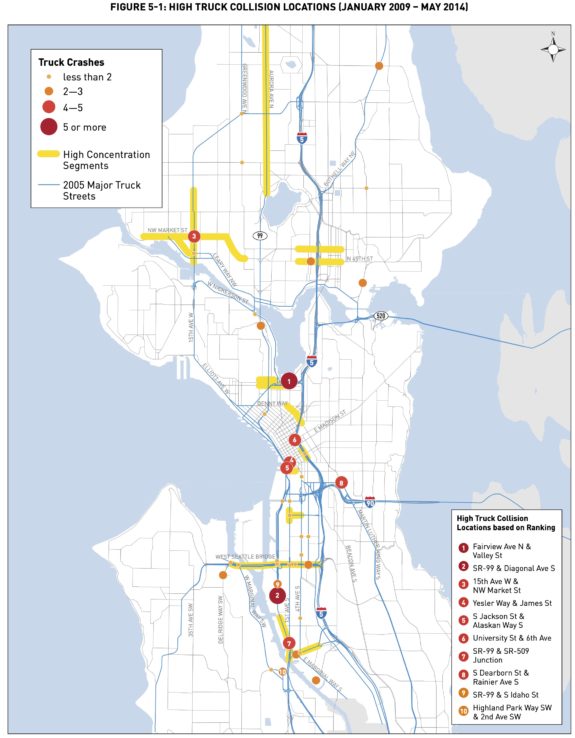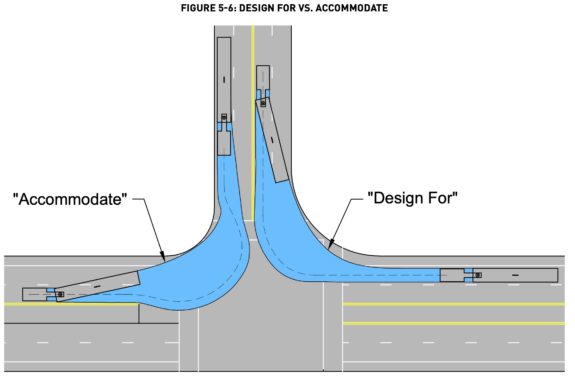Seattle Council, do not pass the resolution to add even more red tape to safety projects
 From the Seattle Freight Master Plan.
From the Seattle Freight Master Plan.Seattle needs to make it easier, not harder, for the Department of Transportation to improve safety on our streets. To that end, the City Council should not pass Resolution 32097, which is scheduled for a vote Tuesday.
The resolution, which was passed unanimously out of the Land Use Committee rather than the Transportation Committee, contains some language that is either very unclear or conflicts with existing city policy and the best design practices for safe streets and accessibility. The resolution requests that SDOT present to both the Freight Advisory Board and the City Council Transportation Committee before making safety improvements to streets designated as Major Truck Streets so that SDOT staff can demonstrat[e] that adjacent land uses and through traffic will not be compromised." It also requests that Seattle prioritize freight movement on streets classified as Major Truck streets in planning, funding, and developing street improvements within and near the Manufacturing Industrial Centers and surrounding areas."
The problem is that safety is Seattle's top priority on Major Truck Streets, or at least it is supposed to be. SDOT just published their full Vision Zero Top-to-Bottom Review" a couple months ago, and it states as its top recommendation: Incorporate Vision Zero and Safe Systems approaches into every project and program." There are no asterisks or exemptions for truck streets here, nor should there be. Even Seattle's Freight Master Plan, which was developed along side freight interests and approved by the City Council, states, The Seattle Department of Transportation's top priority is safety. It is crucial that our freight network provide freight facilities that ensure people driving delivery vehicles and trucks, both large and small, can travel safely among people walking, riding bicycles, taking transit, or driving other vehicles." As the Pedestrian Advisory Board notes in a letter opposing the resolution (see below), Major Truck Routes are already responsible for more than half of all pedestrian fatalities." This is despite these streets making up only 8% of the city's streets.
SDOT should be empowered to act quickly whenever the department has an opportunity to improve safety on these streets. SDOT has never compromised" any freight routes through the implementation of safety improvements. If anything, the city has done freight a disservice by allowing so many major and minor truck streets to continue operating without safety improvements to reduce conflicts with other road users. Operating on streets with an increased risk of injuring or killing somebody is not in a truck driver or freight operator's best interest.
Safety advocates and freight interests are not enemies. This resolution has caught people off-guard, which is creating unnecessary friction. Seattle needs to better coordinate safety and freight work so that everyone is on the same team, and this resolution ain't the way to do that. Instead, look at the plans for E Marginal Way, a major road project on a vital freight street that has been designed from the start with safety at the forefront. Likewise, the emergency 1st Ave S bike lanes during the January Spokane Street Bridge closure were a great example of SDOT moving quickly to successfully address an emerging safety issue while also keeping freight moving on a Major Truck Street. These are not opposing interests. We are all in this together.
It is also very important to recognize that many major truck streets pass near or through low-income communities and communities of color due to the long history of injustices like red lining, so-called urban renewal," and environmental racism. In fact, maybe it's time to retire the term major truck street," which erroneously gives the impression that it is mostly trucks that are operating on them. These are city streets with a special role in the freight network (such as height clearances for oversize loads, etc).
One section in the resolution that is either unclear or problematic calls for SDOT to Implement regulatory and design standards to reduce conflicts between industrial and non-industrial users of the freight network, such as limits on the number and location of curb cuts for non-industrial uses and standards for intersections that provide turning radii that can safely accommodate truck movements." Wide turning radii make intersections more dangerous for all road users because they increase the length of crosswalks, reduce the protected sidewalk space on the corners, and encourage people driving to take turns with more speed. These are all contrary to the city's safety goals. But the resolution uses the term accommodate," which aligns with a section about this in the Freight Master Plan: With the safety of all users in mind, the goal is to allow truck movements for specific truck types at specific locations (context-sensitive), while incorporating the smallest possible curb radius to limit pedestrian crossing distances at intersections and ensure pedestrian safety, following the city's Vision Zero goals." They even included this handy graphic:

There are some promising designs for mountable" curb aprons that encourage smaller vehicles to take slower turns while still allowing truck movements. But also, truck drivers are professionals, and they know how to navigate streets with safer and slower turn radii. They do it all the time. Watch a professional driver miraculously back a full-size trailer up to a loading dock with perfect aim and tell me that person needs us to cut into the street corners so they can make a right turn. It is far more important that our crosswalks and bike lanes are safe. So if this section of the resolution is trying to support developing designs for tight corners that still accommodate" trucks as noted in the Freight Master Plan, then that's great. But the intention as written is not clear.
Additionally, the statement needs to clarify what it means by curb cuts." On my initial reading, I thought they were talking about accessible curb ramps, which are legally-required elements for all marked and unmarked crosswalks. But it could also be a reference to mid-block driveway curb cuts instead, which safety advocates would likely agree are often unnecessary and dangerous. So the Council should clarify that they are not advocating for fewer curb ramps here.
The good news is that the resolution is not strictly binding, but it signals an intention from our City Council that moves in the wrong direction. The Ped Board is asking the Council to vote against the resolution or delay it until its many issues can be better understood. If the Council insists on passing a version of it this week, they should at the very least strike sections A-1 and B while also either striking or clarifying A-7. They should also add safe" to all mentions of prioritizing freight movement and add new language like, Safety for all road users must be the highest priority on all streets, including major and minor truck streets." Alternatively, the council could strip out all the transportation-related sections and focus this resolution solely on the land use elements. Then they could develop a transportation-focused resolution through the Transportation Committee, which would give them an opportunity to address the issues the Ped Board has raised.
Here's the text of the Ped Board letter:
Resolution-32097-SPAB-FeedbackDownloadAs Co-Chairs of the Seattle Pedestrian Advisory Board (SPAB) we submit this letter with a firm request for your vote against Resolution 32097. The resolution is fundamentally flawed and there is no possibility of amending the current language to adequately safeguard the safety and accessibility of our city's most vulnerable transportation users. The resolution alters the nature and powers of the modal boards (Pedestrian, Bicycle, Transit, Freight, School Traffic Safety Committee) without soliciting their input or allowing sufficient time for comprehensive discussion and consensus-building.
Of utmost concern, the resolution would add restrictions to projects on Major Truck Routes that conflict with the goals of our Transportation Plans. The prevailing data reveals that major Truck Routes are already responsible for more than half of all pedestrian fatalities. We firmly believe that this resolution has the potential to exacerbate safety concerns within our pedestrian environment for the residents of Seattle. It is well-documented that roadways with more lanes and with lanes of greater width more frequently result in pedestrian fatalities.
As it stands, the resolution:
- Will result in the continued increase of pedestrian fatalities on truck routes throughout the City by limiting the City's ability to quickly deploy safety improvements on major truck routes.
- Prioritizes the movement of goods by compelling SDOT to demonstrate that through traffic is not compromised by any project that would reduce the number of widths of lanes on Major Truck Route without consideration for safety of other modes;
- Proposes goals that are in direct conflict with the Transportation Plan, Draft Transportation Plan Update Goals, and Vision Zero Action Plan.
- Does not provide analysis on the potential impacts to racial disparities in and around maritime centers and along existing truck routes, which have traditionally bisected BIPOC and low income populations.
This resolution requires more input from the community and other modal boards which typically meet once a month. As co-chairs of the SPAB, we request additional time to hear from SDOT on how this or a similar resolution would be implemented, how it would impact potential projects and planning efforts, hear the results of an evaluation on impacts to BIPOC and low income communities, consult with our board members and fellow modal board chairs.
We invite Council Member Strauss, the author of this resolution, to join us at our next meeting on October 11th, present the proposed resolution to the full board and hear our comments directly.
Thank you,
Christopher A Grgich, PE PTOE, Seattle Pedestrian Advisory Board Co-Chair
Maria Sumner, Seattle Pedestrian Advisory Board Co-Chair